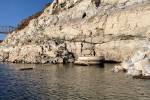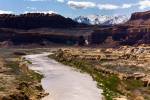COMMENTARY: The dam truth about the Colorado River
The latest research about the Colorado River is alarming and also predictable: In a warming world, snowmelt has been decreasing while evaporation of reservoirs is increasing. Yet no politician has a plan to save the diminishing river.
If you followed the news about the Colorado River for the last year, however, you’d think that a political avalanche had swept down from Colorado’s snowcapped peaks and covered the Southwest with a blanket of “collaboration” and “river protection.”
I won’t call it fake news, but I will point out errors of omission.
First, the Colorado River is not protected. The agreement that was reached — called the Drought Contingency Plan — does not protect the river nor its ecological health. The agreement protects the ability of the federal government, the states, the cities and the farmers to 100 percent drain the river bone dry every single year.
Nearly 5 trillion gallons of water flow in the Colorado every year, and every single drop will continue to be drained out, starting at the Continental Divide in Colorado all the way down to the delta in Mexico where the river still does not, nor is ever planned to, reach the Sea of Cortez.
Second, one of the two elephants in the room, climate change, hangs over the Colorado. The current drought has decreased the flow in the river by about 20 percent, and the predicted increase in climate change may decrease the flow by another 30 percent by 2050. Even the important people making the best decisions admit that the Drought Contingency Plan does nothing to fix this problem. They say they will keep working on it.
The other elephant in the room is one of the most underreported stories in the Colorado River basin: The states, cities and farmers in Colorado, Wyoming, New Mexico, Utah and Arizona are trying to drain more and more water out of the river by building more and more dams, diversions and pipelines.
Using your common sense, you will ask: If the river’s already drained dry, and is predicted to have even less water in it because of climate change, then how can they build more dams, diversions and pipelines?
I always answer by saying: Welcome to the Colorado River, where common sense — as well as simple math — is not used in decision-making.
Twenty-four proposals have been developed to divert more water from the river. Colorado has nine proposals, New Mexico three, Utah seven, Wyoming three and Arizona two. All are in some stage of being built, litigated, going through a permitting process, in pre-permit planning or in a bill before a state legislature or Congress.
If all of these proposals were built, at least another 162 billion gallons of water per year would be drained out of the river. All would need a new and even larger network of dams, pumps and pipelines on a system that is already one of the most dammed and diverted on the planet.
Forty million people, and growing, depend on the Colorado River in the Southwest, which also grows crops that partially feed the entire United States. The river itself supports a large and growing recreational economy. In addition, the river and all of its tributaries are the sole life-support system for a vast and threatened network of plants, birds and animals that have no voice in determining the fate of the waterway. And get this: The same people, cities, states, farmers and governments that created the whole mess are the same people who must fix it.
Want to know the dam truth about the Colorado River? Any new diversion of its water is senseless.
Gary Wockner is a contributor to Writersontherange.org, a nonprofit dedicated to spurring conversation about the West. He runs the nonprofit Save the Colorado and is the author of “River Warrior: Fighting to Protect the World’s Rivers.”




























